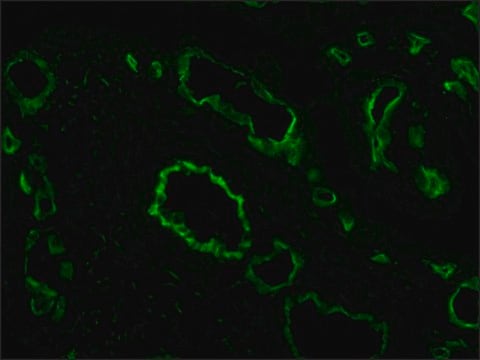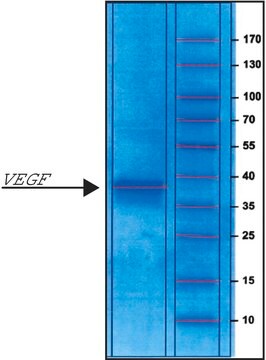Key Documents
ECM002
Thrombospondin-1 human
recombinant, expressed in HEK 293 cells, lyophilized powder, suitable for cell culture
Synonim(y):
THBS, THBS1, TSP, TSP1, Thrombospondin-1
About This Item
Polecane produkty
pochodzenie biologiczne
human
Poziom jakości
rekombinowane
expressed in HEK 293 cells
sterylność
sterile
Próba
≥95% (SDS-PAGE)
Postać
lyophilized powder
masa cząsteczkowa
127.5 kDa (The protein migrates as a 140 kDa band on SDS-PAGE due to glycosylation.)
opakowanie
pkg of 50 μg
metody
cell culture | mammalian: suitable
zanieczyszczenia
≤1 EU/μg endotoxin, tested
rozpuszczalność
water: soluble
numer dostępu NCBI
numer dostępu UniProt
Warunki transportu
dry ice
temp. przechowywania
−20°C
informacje o genach
human ... THBS1(7057)
Opis ogólny
Zastosowanie
- To treat hepatocyte (IHH) cancer cells to study the role of aspartyl protease 1 (MfSAP1) in extracellular matrix degradation.
- In in vitro Extracellular Matrix (ECM) protein degradation assays.
- In rat C6 astroglioma cells, for coating the cell culture plates to study the effects of integrins on CNTF (ciliary neurotrophic factor) expression.
- In the preparation of secreted factor cocktail for analysis of the human mesenchymal stem cell secretome.
Recommended for use as a cell culture substratum at 1-5 μg/cm2 or 0.1-25 μg/ml. Optimal concentration depends on cell type as well as the application or research objectives.
Działania biochem./fizjol.
Cechy i korzyści
- Human-derived thrombospondin
- Produced through recombinant expression in HEK 293 cells
- Low endotoxin levels
Postać fizyczna
Komentarz do analizy
Kod klasy składowania
11 - Combustible Solids
Klasa zagrożenia wodnego (WGK)
WGK 2
Temperatura zapłonu (°F)
Not applicable
Temperatura zapłonu (°C)
Not applicable
Certyfikaty analizy (CoA)
Poszukaj Certyfikaty analizy (CoA), wpisując numer partii/serii produktów. Numery serii i partii można znaleźć na etykiecie produktu po słowach „seria” lub „partia”.
Masz już ten produkt?
Dokumenty związane z niedawno zakupionymi produktami zostały zamieszczone w Bibliotece dokumentów.
Produkty
Attachment Factors for 3-Dimensional Cell Culture
Macierz zewnątrzkomórkowa (ECM) i jej składniki czynnika wiążącego są omówione w tym artykule w odniesieniu do ich funkcji w biologii strukturalnej i ich dostępności do zastosowań in vitro.
The extracellular matrix (ECM) is secreted by cells and surrounds them in tissues.
Nasz zespół naukowców ma doświadczenie we wszystkich obszarach badań, w tym w naukach przyrodniczych, materiałoznawstwie, syntezie chemicznej, chromatografii, analityce i wielu innych dziedzinach.
Skontaktuj się z zespołem ds. pomocy technicznej







